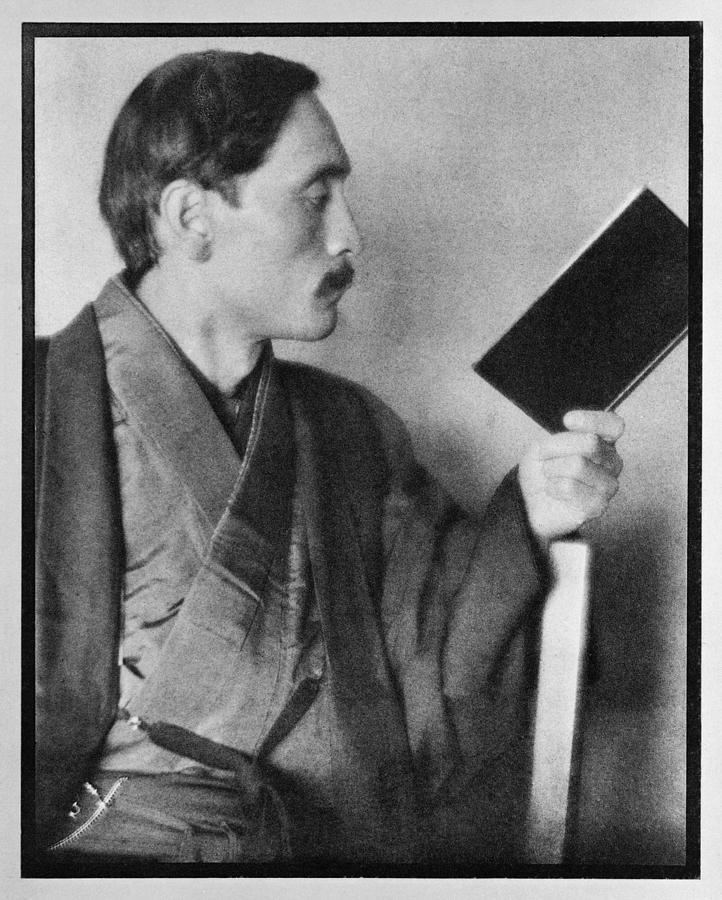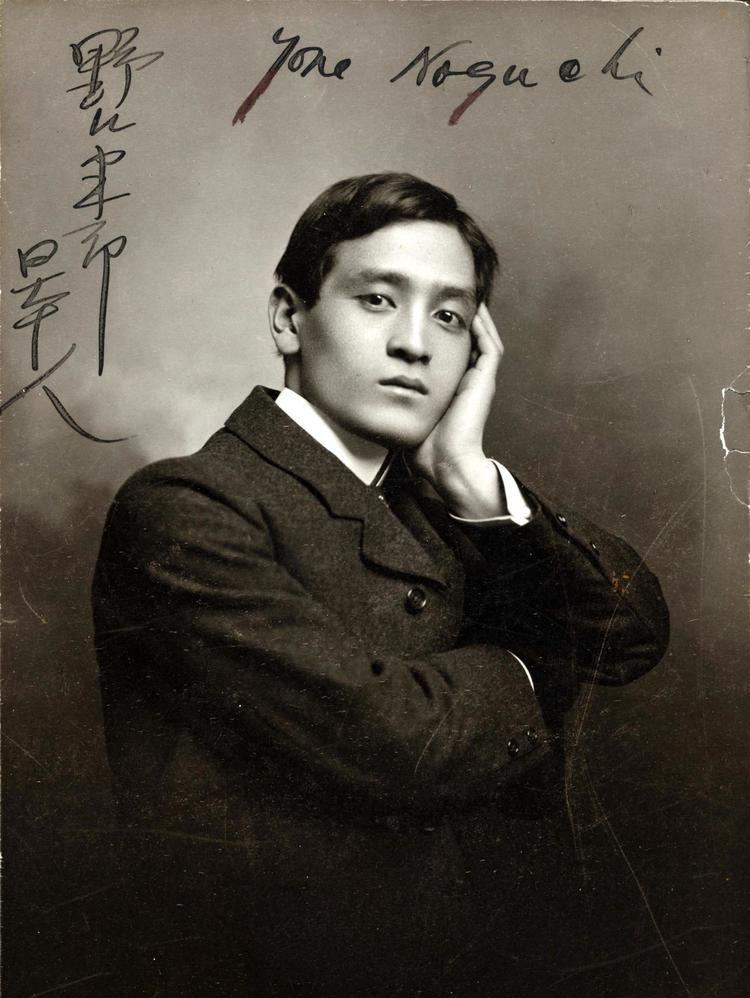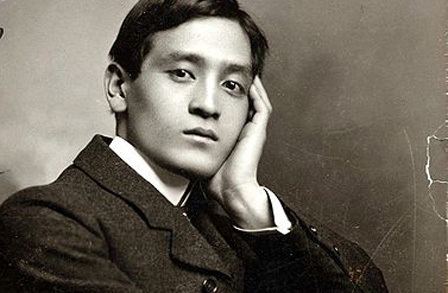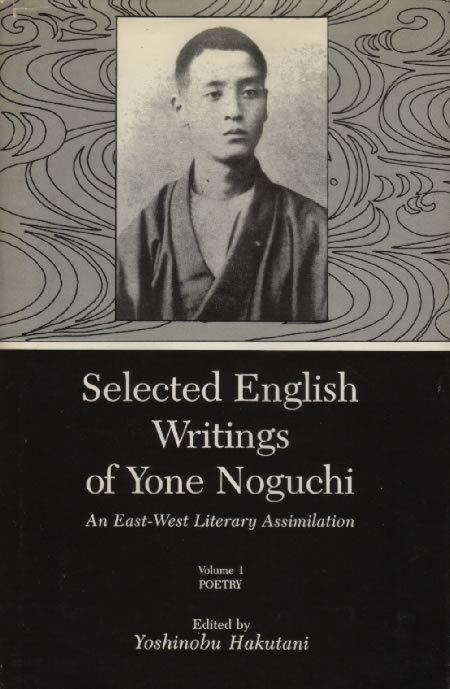Pen name Yone Noguchi Name Yone Noguchi Nationality Japan Role Writer | Period 1897–1947 Children Isamu Noguchi | |
 | ||
Born December 8, 1875Tsushima, Aichi, Japan ( 1875-12-08 ) Occupation Poet, essayist, literary critic Died July 13, 1947, Tokyo, Japan Books The American Diary of a, Japanese Hokkus, Lafcadio Hearn in Japan, The Spirit of Japanese, Later Essays Similar Léonie Gilmour, Ailes Gilmour, Isamu Noguchi | ||
Selected Poems of Yone Noguchi | Yone Noguchi | Poetry | Book | English
Yonejirō Noguchi (野口 米次郎, Noguchi Yonejirō, December 8, 1875 – July 13, 1947), was an influential Japanese writer of poetry, fiction, essays, and literary criticism in both English and Japanese. He is known in the West as Yone Noguchi. He was the father of noted sculptor Isamu Noguchi.
Contents
- Selected Poems of Yone Noguchi Yone Noguchi Poetry Book English
- Early life
- Career
- Late life
- Critical evaluations
- Contributions to periodicals
- References

Early life

Noguchi was born in what is now part of the city of Tsushima, near Nagoya. He attended Keio University in Tokyo, where he was exposed to the works of Thomas Carlyle and Herbert Spencer, and also expressed interests in haiku and Zen. He lived for a time in the home of Shiga Shigetaka, editor of the magazine Nihonjin, but left before graduating to travel to San Francisco in November 1893. There, Noguchi joined a newspaper run by Japanese exiles associated with the Freedom and People's Rights Movement and worked as a domestic servant. He spent some months at Palo Alto, California studying at a preparatory school for Stanford University and working as a journalist before determining, after a visit to the Oakland hillside home of Joaquin Miller, his true vocation of poet. Miller welcomed and encouraged Noguchi and introduced him to other San Francisco Bay area bohemians, including Gelett Burgess (who published Noguchi's first verses in his magazine, The Lark), Ina Coolbrith, Edwin Markham, Adeline Knapp, Blanche Partington, and Charles Warren Stoddard. Noguchi weathered a plagiarism scandal in 1896 to publish two books of poetry in 1897, and remained an important fixture of the Bay Area literary scene until his departure for Chicago in 1899. He submitted articles for the evening edition of the New York Post, and moved on to the East Coast in 1900.
Career

From 1900 to 1904, Noguchi's primarily base was New York City. There, with the help of editor and future lover Léonie Gilmour, he completed work on his first novel, The American Diary of a Japanese Girl, and a sequel, The American Letters of a Japanese Parlor-Maid.

Noguchi then sailed to England, where he self-published and promoted his third book of poetry, From the Eastern Sea, and formed connections with leading literary figures like William Michael Rossetti, Laurence Binyon, William Butler Yeats, Thomas Hardy, Laurence Housman, Arthur Symons and the young Arthur Ransome. His London success brought some attention on his return to New York in 1903, and he formed productive new friendships with American writers like Edmund Clarence Stedman, Zona Gale, and even Mary MacLane, but he continued to have difficulty publishing in the United States.

This changed with the onset of the Russo-Japanese War in 1904, when Noguchi's writings on various aspects of Japanese culture were suddenly in great demand among magazine editors. He was able to publish a number of seminal articles at this time, including "A Proposal to American Poets," in which he advised American poets to "try Japanese hokku."

Having (he thought) ended a brief, secret marriage to Léonie Gilmour in the early months of 1904, Noguchi made plans to return to Japan, with the intention of marrying another romantic interest, Washington Post reporter Ethel Armes. He returned to Japan in August 1904, and became a professor of English at his alma mater Keio University the following year, but his marriage plans were spoiled when it became known that Léonie Gilmour had given birth to Noguchi's son (the future sculptor Isamu Noguchi) in Los Angeles. He moved to the Koishikawa neighborhood of Tokyo in November 1905, and published an anthology of prose poetry in English, The Summer Cloud, shortly thereafter.
From November 1906 to January 1908, Noguchi literary criticism column almost every week for the Japan Times, among the more notable of which was the November 3, 1907 "Mr. Yeats and the No," advising William Butler Yeats to study the Noh drama. "He has been attempting to reform and strengthen the Western stage through his own little plays which are built on Irish legend or history; and so far, in his own way, he is successful. I feel happy to think that he would find his own ideal in our No performance, if he should see and study it." After studying Ernest Fenollosa's Noh translations with Ezra Pound, Yeats staged his first Noh-style play, At the Hawk's Well, in 1916, eliciting Noguchi's approval in another Japan Times column.
In 1907, Léonie and Isamu joined Noguchi in Tokyo, but the reunion proved short-lived, mainly because Noguchi had already married a Japanese woman, Matsu Takeda, before their arrival. He and Léonie separated for good in 1910, although Léonie and Isamu continued to live in Japan.
Noguchi continued to publish extensively in English after his return to Japan, becoming a leading interpreter of Japanese culture to Westerners, and of Western culture to the Japanese. His 1909 poem collection, The Pilgrimage, was widely admired, as was a 1913 collection of essays, Through the Torii. In 1913, he made his second trip to England (via Marseille and Paris) to lecture on Matsuo Bashō and haiku at Magdalen College, Oxford at the invitation of poet laureate, Robert Bridges. He was hailed in the pages of Poetry as a pioneering modernist, thanks to his early advocacy of free verse and association with modernist writers like Yeats, Ezra Pound, Richard Aldington, and John Gould Fletcher. While in London, he met with George Bernard Shaw, H. G. Wells, Edward Carpenter and other noted literary figures. In April the following year, while in Paris, he also met with Tōson Shimazaki who happened to be travelling in Europe at the time. Noguchi returned to Japan via Berlin and Moscow using the Trans-Siberian Railway. In 1919–20, Noguchi made a transcontinental lecture tour of America.
By the early 1920s, however, Noguchi's work had fallen into critical disfavor, and he subsequently devoted his English efforts to studies of ukiyo-e, while beginning a somewhat belated career as a Japanese language poet. Noguchi's success as a Japanese poet has been questioned by Japanese scholars; Norimasa Morita states that Noguchi "struggled to make a literary reputation for himself in Japan" and that "most of his Japanese poems received no critical or popular recognition". Other scholars including Madoka Hori point to evidence of Noguchi's success such as the May 1926 Noguchi Yonejiro special number of the magazine Nippon Shijin (The Japanese Poet). All of Noguchi's later books, in both Japanese and English, were published in Japan, for Noguchi encountered stiff resistance from American publishers in the 1930s, despite the support of a few sympathetic editors like Marianne Moore.
Late life
Noguchi's politics tended to follow prevailing Japanese tendencies. In the 1920s, following the leftist turn of Taishō democracy, he published in leftist magazines like Kaizō, but the 1930s, he followed the country's turn to the right. Partly as a result of his friendship with leading Indian intellectuals like Rabindranath Tagore, Sarojini Naidu, and Rash Behari Bose, Noguchi was sent to India in 1935–36 to help gain support for Japanese objectives in East Asia, but he had little success. Noguchi and Tagore had a bitter exchange of letters in 1938 before their friendship ended over political and philosophical differences. During the Second World War, Noguchi supported the Japanese cause, advocating a no-holds-barred assault on the Western countries he had once admired.
In April 1945, his house in Nakano, Tokyo was destroyed in the American Bombing of Tokyo. After the war, he succeeded in reconciling with his estranged son Isamu before dying of stomach cancer on July 13, 1947.
Critical evaluations
Critical evaluations of Noguchi, while varying drastically, have frequently stressed the enigmatic character of his work. Arthur Symons referred to him as a "scarcely to be apprehended personality." Arthur Ransome called him "a poet whose poems are so separate that a hundred of them do not suffice for his expression." Ezra Pound, on first reading The Pilgrimage in 1911 wrote that "His poems seem to be rather beautiful. I don't quite know what to think about them." Nishiwaki Junzaburō wrote, "Most of his earlier poems have always seemed to me so terrific, so bewildering, as to startle me out of reason or system."
Noguchi may be considered a cross-cultural, transnational, or cosmopolitan writer. His work may also be considered, albeit somewhat more problematically, within the national literatures of Japan and the United States (see Japanese literature, American literature). Noguchi has recently gained attention in Asian American studies due to the increasing interest in transnationalism.
Yone Noguchi is played by Nakamura Shidō II in the film Leonie (2010).
Contributions to periodicals
Noguchi contributed to numerous periodicals in the United States, Japan, England, and India, including: The Academy, Blackwood's, The Bookman, The Bookman, The Calcutta Review, The Chap-Book, Chūōkōron, The Conservator, The Dial, The Double-Dealer, The Egoist, The Graphic, The Japan Times, Kaizō, The Lark, Frank Leslie's Popular Monthly, Mainichi Shinbun, The Modern Review, Myōjō, The Nation (London), The Nation (New York), The Philistine, Poetry Magazine, Poet Lore, The Poetry Review, The Reader Magazine, Sunset Magazine, T'ien Hsia Monthly, T.P.'s Weekly, Taiyō, Teikoku Bungaku, The Visva-Bharati Quarterly, The Westminster Gazette, and Yomiuri Shinbun.
